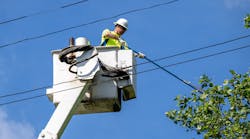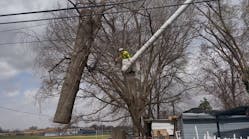Electrical Hazard Awareness for Utility Vegetation Management and Beyond
In our industry, electrical hazards are widespread — from encountering 12-kilovolt (kV) lines to overloading a circuit in an office. The bandwidth of these hazards is wider than you’d expect. While it’s natural to assume most electrical hazards occur outdoors, think about an extension cord that’s frayed or not taped down. Picture a surge protector with plugs, plugs, and more plugs.
Regardless of your role in an organization, the risk of electrical hazards still applies. Being aware of these hazards and avoiding them can literally be the difference between life and death.
An article by EHS Today details the six most common electrical hazards:
- Overhead powerlines
- Damaged equipment
- Inadequate wiring and overloaded circuits
- Exposed electrical parts
- Improper grounding
- Damaged insulation
According to the Tree Care Industry Association (TCIA), electricity causes approximately 15 percent of all fatalities in the tree care industry, making it the leading cause of worker fatalities with the tree industry having the highest death rate per 100,000 workers. This is a concern, and proper training is paramount to mitigate any risks one may encounter while in the field.
Common ways utility vegetation management (UVM) workers come near electricity is by transmission and distribution lines. These lines typically can carry voltage anywhere between 12,000 to 500,000 volts and have different configurations. Sometimes, they are stacked over each other and can have primary and secondary transmission lines running below several distribution lines.
Someone who works in our industry may come in proximity of these devices during the normal scope of work- whether walking the lines to inspect trees, working with a tree crew to cut trees that may be a hazard to the lines or devices, or working wood management and cleaning up brush piles. Regardless of what work is being done, the hazard of electricity is always present.
Some best practices to avoid being electrocuted are:
Assume all lines are energized and avoid them. If a line is touching the ground or an object, that object can be energized and potentially cause death if touched. This is called step potential. Stay away from it and call the utility emergency telephone number or 911. Tell other people to stay away from the lines if they approach.
A five-minute meeting by ACRT Arborist Training explains while it’s important to note that insulated tools and bucket trucks provide some measure of protection for workers, keeping tools in good condition and clean from dirt and moisture can further limit the potential of the tools becoming energized since dirt and moisture have lower resistance to electric flow.
Step potential refers to the difference in voltages between your feet when standing near a downed power line and your feet when in different rings of electrical current. The difference in voltage between your feet can cause the electrical current to enter and surge through your body. When a power line is downed, it gives off an electrical current that “spills” onto the ground, flowing outward and away from the power, which subsequently creates a type of ripple effect. The voltage of the line’s current is higher near the power line and diminishes as it gets further away.
This ripple effect means that as you walk toward or away from a downed power line or any conductor of electricity, you are stepping into invisible rings of electric current with differing voltages. Each step can cause your feet to land in different rings. This can cause the electric current in one ring to enter your body through one leg on its path to find the ground, surge through your body, and exit through your other leg into the second ring of current.
Do not break the minimum approach distance (MAD) unless you are trained to do so. Generally, that is 10 feet for 12-kV lines, and as the kV increases, so does the MAD.
Table 3 in the ANSI Z.133 Safety Standard provides the minimum approach distance (MAD) chart for line clearance arborists to assist with maintaining safe distances from energized conductors while working. According to the table, as voltage increases along an electrical conductor, the minimum safe distance from that conductor also increases.
- Shuffle away from the downed power line. This involves putting your feet together, keeping them in constant contact by always keeping them on the ground, and shuffling so that one foot shuffles forward along the length of the other foot.
- Bunny-hop away from the downed power line. Put your feet together and hop out of the area while your feet are always together.
- Call 911.
- Call the power company.
- Avoid any direct or indirect contact with any objects as you are leaving the area for safety.
The most important thing you can do is utilize situational awareness, look around, and make sure you are safe before you do any wor
M.K. Youngblood serves as the safety manager and tribal liaison at ACRT Pacific. He has more than 30 years of public service and first responder experience with core proficiency in American Indian law, American Indian culture, and disaster cleanup. Youngblood also serves as a certified instructor for the U.S. Department of Energy (National Nuclear Security Administration and Center for Radiological Nuclear Training), U.S. Emergency Management Institute, and Center for Domestic Preparedness. He has earned his California Naturalist designation from UC Davis and serves as the tribal historic preservation officer for the Haslett Basin Holkama Mono Nation in Fresno, California.



